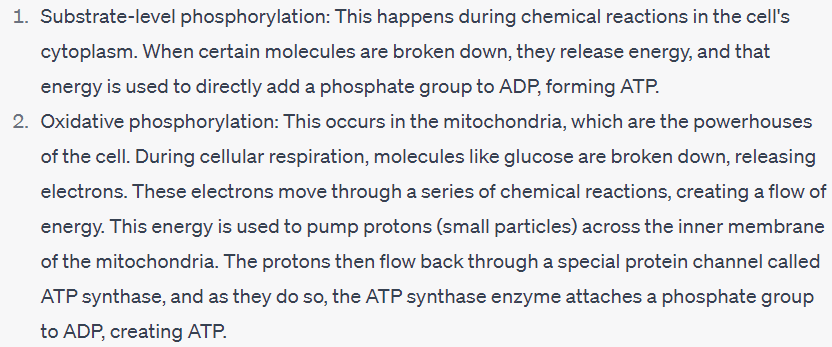Cell Biology Primer - Flashcards
4.3(3)
4.3(3)
Card Sorting
1/26
Earn XP
Description and Tags
Study Analytics
Name | Mastery | Learn | Test | Matching | Spaced |
|---|
No study sessions yet.
27 Terms
1
New cards
Name the 6 levels of organisation
organelle → cell → tissue → organ → organ system → organism
2
New cards
key characteristics of an organelle
inside a cell; there are various types with different functions
3
New cards
key characteristics of a cell
all living organisms have cells; cells are the building blocks of life
4
New cards
key characteristics of a tissue
cells are organised into tissues that do certain jobs; many different types of cells can work together to make a tissue function
5
New cards
key characteristics of an organ
has a more general function; made up of tissue(s)
6
New cards
key characteristics of an organ system
organs work together to fulfil specific roles in the body
7
New cards
key characteristics of an organism
comprised of multiple different organ systems
8
New cards
what do cells do (jobs)?
* detecting
* signalling
* digesting, absorbing or transporting
* fighting infection
* moving
* signalling
* digesting, absorbing or transporting
* fighting infection
* moving
9
New cards
what do cells do (processes)?
* make things
* break things down
* change membrane voltage
* secrete/transport things
* detect things
* break things down
* change membrane voltage
* secrete/transport things
* detect things
10
New cards
features of the cell membrane
a thin coat of phospholipids that surrounds the cell and controls what enters and leaves the cell
11
New cards
features of cytoplasm
the material inside the cell membrane; includes watery cytosol and other cell structures (except the nucleus if present)
12
New cards
what is cytosol made of?
* water (\~70%)
* Ions, e.g. Na+, Ca2+
* small molecules, e.g. ATP, NADH, glucose
* amino acids
* soluble proteins, e.g. calmodulin, protein kinase C
* Ions, e.g. Na+, Ca2+
* small molecules, e.g. ATP, NADH, glucose
* amino acids
* soluble proteins, e.g. calmodulin, protein kinase C
13
New cards
features of the cytoskeleton
consists of filaments and tubules that crisscross the cytoplasm and help maintain the cell’s shape
14
New cards
features of the nucleus
contains most of the cell’s DNA; acts as the control centre of the cell
15
New cards
features of DNA
a nucleic acid found in cells; contains the genetic instructions for making proteins
16
New cards
features of ribosomes
structures found in all cells; the site of protein synthesis
17
New cards
features of endoplasmic reticulum
an organelle that helps make proteins and lipids; transports proteins in the cell
18
New cards
features of the Golgi apparatus
an organelle that modifies, sorts, and packages proteins for secretion out of the cell/use in the cell
19
New cards
features of lysosomes
organelles that use enzymes to break down molecules so their components can be recycled
20
New cards
features of mitochondria
organelles that use energy stored in glucose to make ATP (which cells can use for energy)
21
New cards
what is ATP?
adenosine triphosphate
22
New cards
what does ATP do?
* Drive reactions (e.g. protein synthesis)
* muscle contraction and dilation
* move molecules against gradients
* transport proteins or organelles around the cell
* move microtubules to allow cells to craw; or processes to move
* produce heat to maintain body temperature
* muscle contraction and dilation
* move molecules against gradients
* transport proteins or organelles around the cell
* move microtubules to allow cells to craw; or processes to move
* produce heat to maintain body temperature
23
New cards
describe the process of making a protein
transcription → splicing → export → translation → folding → protein
24
New cards
what is alternative splicing?
RNA-binding proteins chop out introns and stick exons together; different RNA-binding proteins in a given cell stick different exons together; get lots of different proteins made from a single gene
25
New cards
what are the four protein structures?
* amnio acid (primary structure)
* α-Helixes (secondary structure)
* polypeptide chains (tertiary structure)
* complex of protein molecule (quaternary structure)
* α-Helixes (secondary structure)
* polypeptide chains (tertiary structure)
* complex of protein molecule (quaternary structure)
26
New cards
examples of how different cells express different proteins
* red blood cells express haemoglobin (tetramer)
* pancreatic beat cells express insulin (hexamer)
* neurons express ion channels
* muscle cells express myosin and actin
* pancreatic beat cells express insulin (hexamer)
* neurons express ion channels
* muscle cells express myosin and actin
27
New cards
ATP synthesis
* when cells need energy they break down ATP into ADP and inorganic Phosphate (Pi) which releases energy
* ATP is synthesised via substrate-level phosphorylation and oxidative phosphorylation
* ATP is synthesised via substrate-level phosphorylation and oxidative phosphorylation
